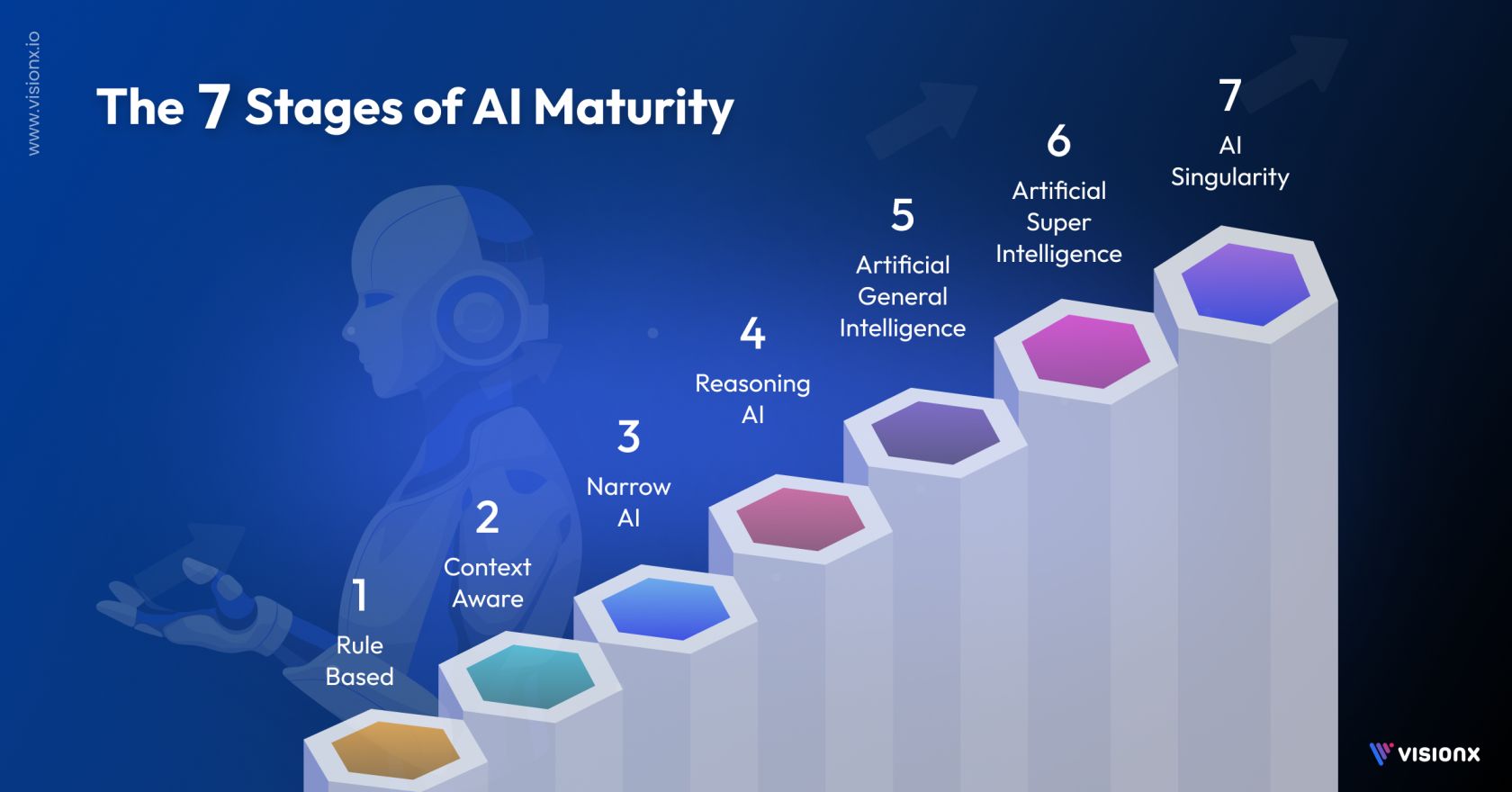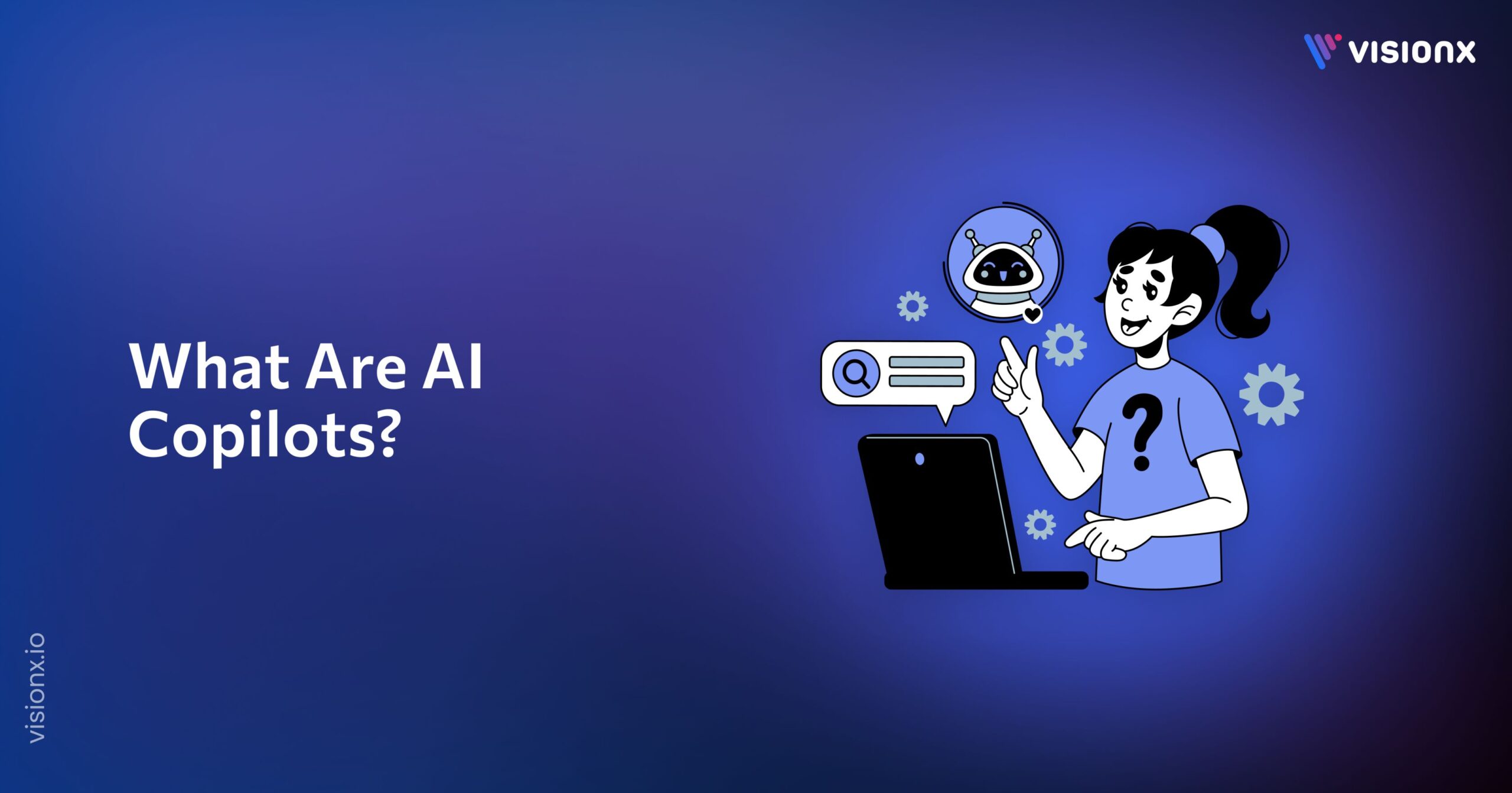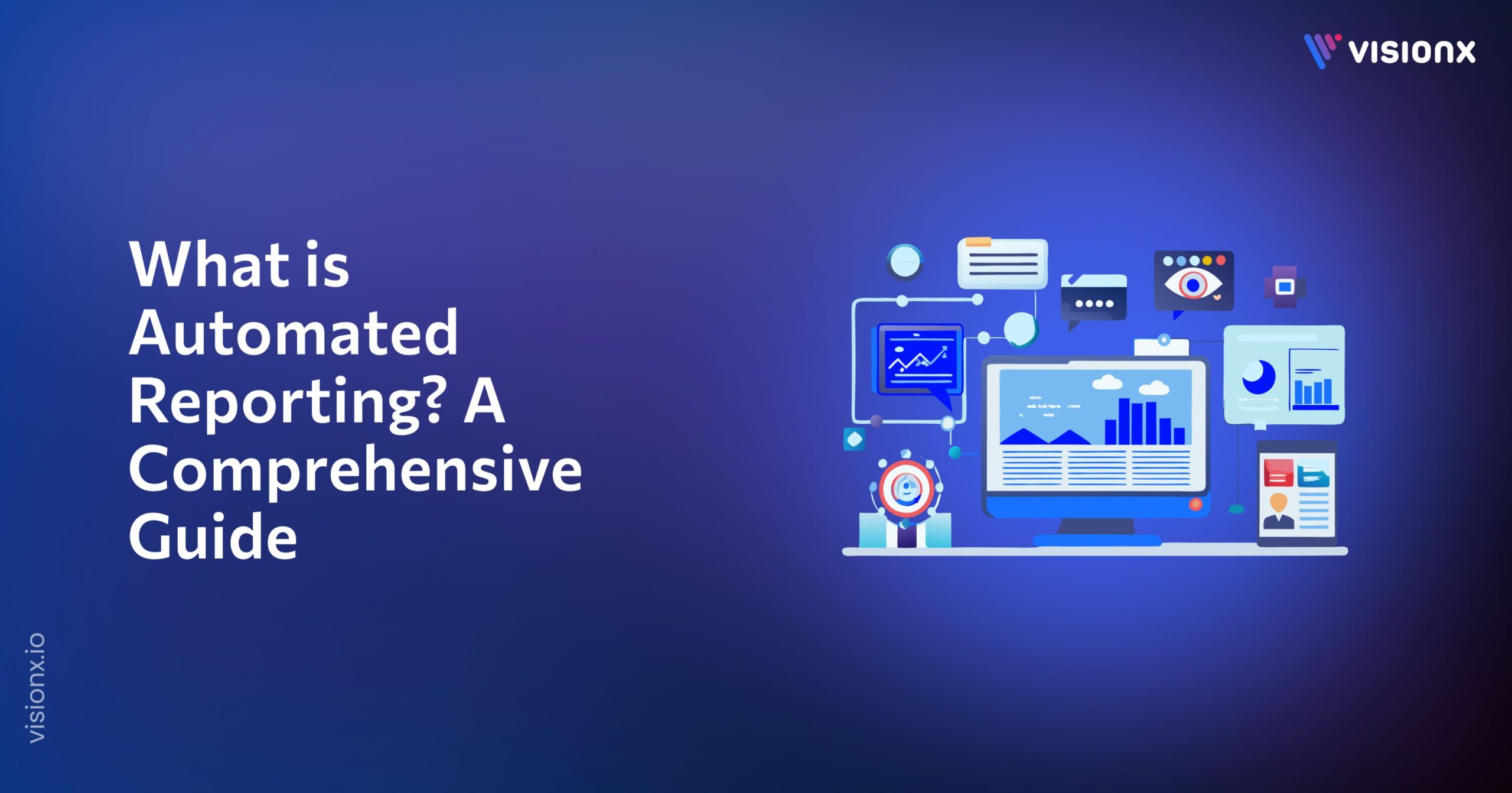You may have seen AI write text, recognize faces, and suggest what to watch next. But it didn’t start there. In the beginning, machines followed fixed rules. No learning. No insight. Just simple logic. That was the first step in the stages of artificial intelligence.
As you move through time, each level of AI reveals more. Your AI begins to learn. Then predict. And then create something extraordinary. According to McKinsey, 65% of organizations use AI to change how they operate. This is almost double last year’s figure.
In this post, you’ll explore the 7 stages of AI development. These phases of AI show how machines move from basic commands to something far more complex. And where you fit in that story matters.
What are the Stages of AI?
The stages of AI explain the progression of AI from simple rule-based systems to more advanced forms of intelligence. Each stage depicts the evolution of AI in its ability to process information, learn from past data, and move towards human-like intelligence or maybe even exceeding human capabilities.
These stages of AI development give us a framework to understand where AI is today, how it has developed over time, and what the future of AI might look like.
The 7 Stages of AI
The stages of artificial intelligence help you see how AI grows over time. You start with basic systems that follow rules. Then you move through each level as AI gains new skills. It begins to reason. It starts to solve hard problems. This framework helps you understand where AI stands now. These different stages of AI development also show what you can expect next.

Stage 1: Rule-Based Systems
This is where AI stages begin. You see simple, rule-based machines that follow strict logic. Every action comes from an IF-THEN rule. There’s no room for doubt. No room for change.
These systems do not think. They only follow instructions set by programmers. If you change the input, the system might fail. It can’t adapt. That’s why many call it brittle.
Still, this stage plays a big role. You find early expert systems built on these rules. For example, in the 1970s, researchers created MYCIN as a medical expert system. It showed that rule-based AI can aid in decision-making. Doctors entered patient symptoms, and the system suggested treatments for bacterial infections. But if new conditions appeared outside its logic, it failed to respond.
This step in the stages of AI development shows the first serious attempt to copy human logic. It’s slow. It’s rigid. But it sets the foundation for everything that comes next.
Stage 2: Context Awareness and Retention (Limited Memory AI)
At this AI stage, you move beyond static responses. AI no longer reacts in isolation. It starts to remember short-term data and uses it to make better choices.
This change adds depth. Your system begins to recognize patterns over time. It observes, learns briefly, and adjusts. In machine learning, this is known as limited memory AI. It allows AI to consider recent events when making decisions. In this stage of AI development, these systems not only carry out instructions, but they also use previous data to learn from it and produce human-like responses.
For example, self-driving cars use limited memory to make real-time decisions. They track nearby vehicles, traffic signals, and pedestrian movement. This is not just reacting. It is adapting based on context. Modern recommendation engines also rely on recent user activity. They adjust suggestions not just based on who you are, but on what you have just done.
This step brings real progress in the stages of AI. It pushes machines to become more situationally aware. More like us, even if just for a moment.
Stage 3: Domain-Specific AI (ANI)
This is the current stage of AI, also known as Artificial Narrow Intelligence (ANI), where your machines are good at only one specific task. At this point, your AI becomes highly skilled, but only in one area. It does not understand the world as a whole, but it performs one task incredibly well. You train AI for a specific job. And it often outperforms humans in that area.
You begin to notice real progress in:
- Facial recognition
- Medical diagnostics
- Customer service chatbots
AI is not thinking like a human, but it is solving problems faster and more accurately than ever before. Within these levels of AI, your AI system processes large volumes of data, detects trends, and makes smart decisions in its particular domains.
For example, a medical AI that scans X-rays. It does not know what a human is or what a hospital looks like. But it can detect signs of disease better than many doctors. It was trained on thousands of images and learned what to look for. It performs this one task with precision.
Your AI is not general-purpose yet. It cannot jump from one task to another. But within its area of focus, it becomes a powerful tool. This is the moment when you start to see real-world value, and when AI begins to feel essential.
Stage 4: Reasoning Machines (Theory of Mind)
At this level in the 7 stages of AI development, your AI begins to do more than analyze data. It starts to grasp that people have thoughts, feelings, and goals. The system moves toward understanding how humans behave and why they act a certain way.
You notice AI trying to interpret intent. It looks at tone, expression, and patterns in behavior. It does not just respond to what you say. But it tries to make sense of what you mean. This idea is linked to something called a theory of mind.
For example, a digital assistant that knows when you’re stressed. It hears the tension in your voice and shortens its responses. It offers calm reminders instead of detailed instructions. It tries to be helpful in a more human way.
AI is not fully self-aware. It does not truly understand emotions. But it starts to reason through interactions. It becomes less robotic and more thoughtful in how it responds to people.
Stage 5: Artificial General Intelligence (AGI)
This phase in the stages of AI shows the AI progression from narrow to general intelligence. Artificial General Intelligence (AGI) exists primarily as a theoretical concept and is yet to be accomplished. This stage of AI describes machines with human-like intelligence and problem-solving skills. AGI differs from earlier AI. It is capable of understanding, learning, and applying knowledge to any task just like a human does.
For example, multimodal agents use text, images, and audio. This helps them interact more like humans. While AGI has not arrived yet, progress with these agents shows its potential.
Artificial general intelligence (AGI) sparks debates about its feasibility and impact. It marks a key phase in the 7 stages of AI. The future of AI depends on whether machines can truly match human intelligence.
Comparing ANI, AGI, and ASI
Below is a comparison between the 3 stages of AI, ANI, AGI, and ASI to help you better grasp where AGI fits into the larger AI ecosystem.
| Type of AI | Definition | Key Capabilities | Example Tasks | Real-World Examples |
| ANI (Artificial Narrow Intelligence) | AI specializes in one domain or particular task | Highly efficient, accurate, but limited to specific use cases | 1. Facial recognition
2. Spam email filtering 4. Medical image analysis |
Siri, Alexa, Google Translate, ChatGPT (narrow domain) |
| AGI (Artificial General Intelligence) | Human-level intelligence that can understand, learn, and apply knowledge across multiple domains | Flexible reasoning, problem-solving, and adaptation | 1. Learn a new language
2. Solve math, write stories, and diagnose medical conditions, all without retraining 3. Adapt to new tasks without domain-specific training |
Not yet achieved. It is a theoretical stage of AI that is under research. |
| ASI (Artificial Super Intelligence) | Intelligence surpassing human cognition in every aspect | Self-improving, creative, strategic, and faster than human brains | 1. Discover new medicines
2. Solve unsolved physics problems 3. Manage global economies 4. Create novel technologies beyond human imagination |
Hypothetical stage. It does not exist yet. |
Stage 6: Artificial Super Intelligence (ASI)
At this level of AI stages, AI surpasses human intelligence in every way, such as creativity, problem-solving, and wisdom. It thinks faster and solves problems more creatively and deeply than any person can.
AI understands complex ideas, adapts instantly, and can improve itself without help. It can learn and innovate in all areas, like science, art, and social interactions.
For instance, an AI can create new medicines, invent technologies, and predict global events accurately. It works independently, far beyond what humans can manage.
This phase in the 7 stages of AI offers incredible possibilities but also brings serious risks. It’s crucial to make sure it matches human values and safety. This could change how the world works.
Stage 7: The AI Singularity
This is the stage where AI is expected to exceed human intelligence, leading to unpredictable changes in technological growth. This is known as the AI singularity. It is a moment when machines could outperform people in almost every task.
This stage raises serious ethical concerns. You must consider questions about control, alignment, and value misalignment between humans and machines. The challenge lies in ensuring AI acts in ways that benefit humanity.
This final stage of AI evolution completes the journey from rule-based AI to AI singularity. It represents the ultimate frontier in the 7 stages of AI and the evolution of artificial intelligence.
How Each Stage Changed Our Lives?
You can see the impact of AI on every part of life. Early rule-based systems helped doctors diagnose diseases. Statistical learning improved credit scoring in finance. Deep learning powers image recognition in the retail industry for personalized shopping.
Autonomous systems speed up logistics with warehouse robots and self-driving vehicles. Generative AI creates content that changes how you work and communicate. In fact, according to a McKinsey report, generative AI could add up to $4.4 trillion in annual global productivity across industries.
Each phase of AI development reshapes industries and daily routines. This clear mapping of the stages of AI evolution shows how technology evolves to serve human needs.
Understanding the Levels of AI Maturity
You might wonder how organizations measure their progress with AI. The concept of levels of AI maturity helps answer this question. It shows how companies grow from basic AI tests to fully integrated, AI-driven businesses.
Most organizations start with exploration, testing AI tools in limited areas. Then they move to adoption, where AI supports core functions. At higher levels, AI becomes embedded across processes, enabling automated decisions and insights. The top maturity stage is all about constant innovation. Here, AI creates new products and business models.
Several popular frameworks exist to assess these levels. For example, the AI Maturity Model by Deloitte evaluates strategy, technology, and governance. Another framework by Gartner looks at AI adoption, scaling, and optimization.
Understanding these levels of AI can guide your organization’s AI journey. You gain clarity on strengths and areas needing improvement. As companies evolve through these stages of AI, they unlock more value and competitive advantage.
How VisionX Can Guide Your AI Journey
Partnering with VisionX means more than hiring a service provider. You gain a trusted ally. We understand AI maturity levels and will guide you through every step of your AI journey. Whether you use simple rule-based systems or advanced generative AI, we tailor solutions to fit your needs.
Our team helps you build, integrate, and scale AI technologies that align with your business goals. We have deep technical skills and strong industry knowledge. We simplify tough AI limitations, so you can concentrate on growth and innovation.
With VisionX, you lead in artificial intelligence. You unlock new opportunities and stay ahead of your competition.
FAQs
What are the 7 stages of artificial intelligence?
The 7 stages of AI represent the key phases in AI’s evolution. They begin with simple rule-based systems. Then, they move to statistical learning, deep learning, and generative AI. After that, they explore autonomous systems and artificial general intelligence. Finally, they reach the AI singularity.
What is the AI Singularity?
The AI singularity is a hypothetical stage where AI surpasses human intelligence in nearly every way. It raises key ethical questions about control, alignment, and our future with machines.
What are the 5 stages of the AI cycle?
The 5 stages of the AI cycle are problem identification, data preparation, model development, testing and validation, and deployment with ongoing optimization.
What stage of AI are we in right now?
Currently, we are in a stage dominated by generative AI and foundation models. These systems make content, code, and images. They are changing industries like healthcare, finance, and retail.
About Author

M. Waqas Mushtaq is the Co-Founder and Managing Director of VisionX, whose passion for innovation fuels the company’s growth. Under his strategic direction, VisionX promotes a culture of excellence, solidifying its position as an industry leader.


